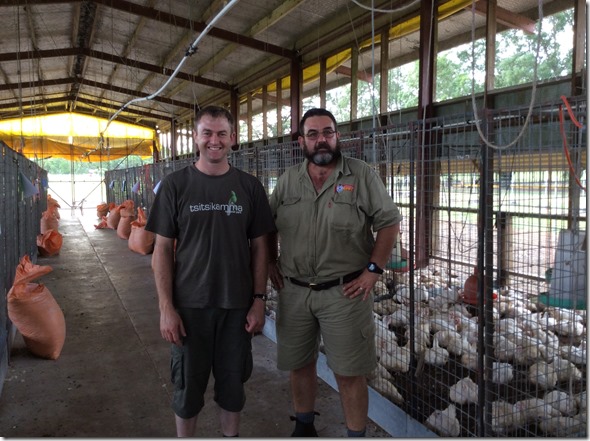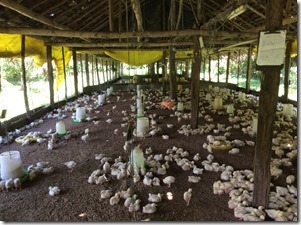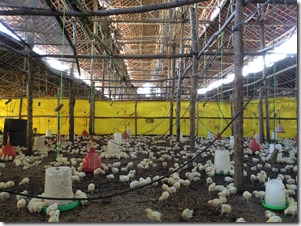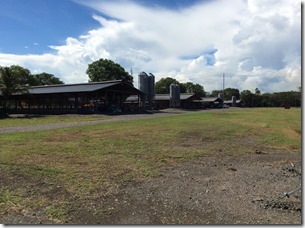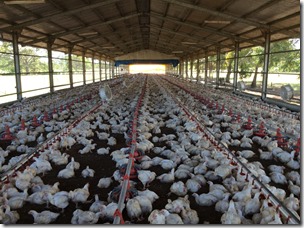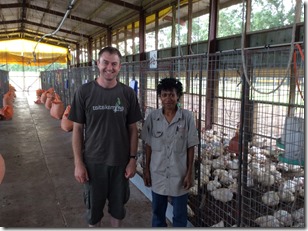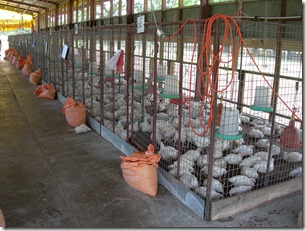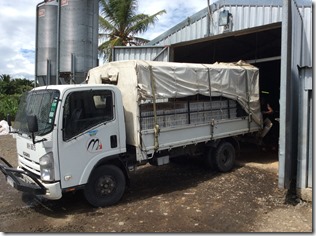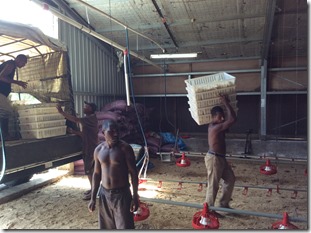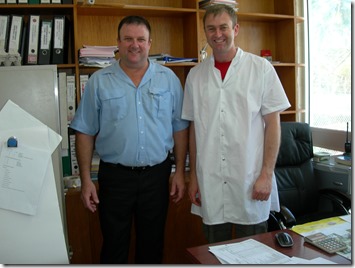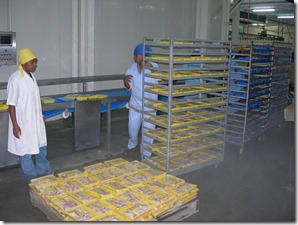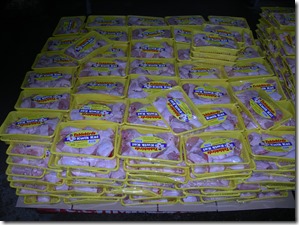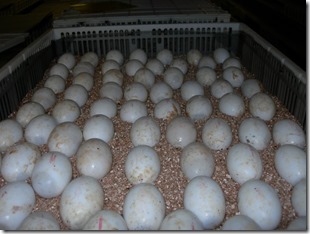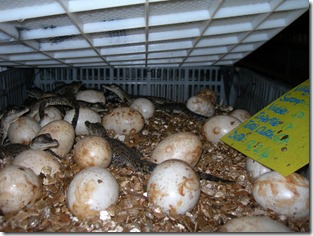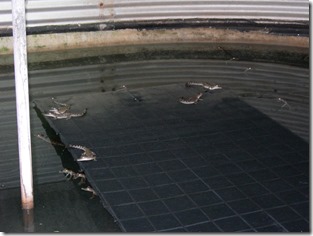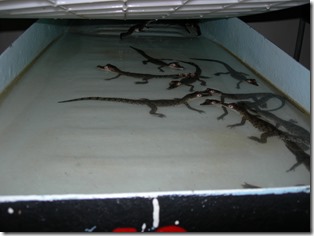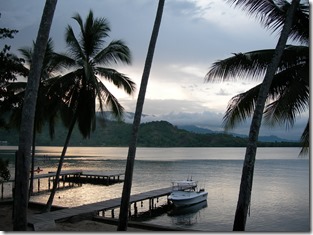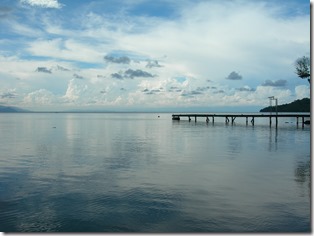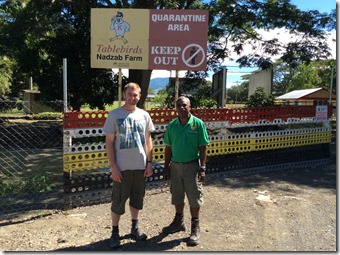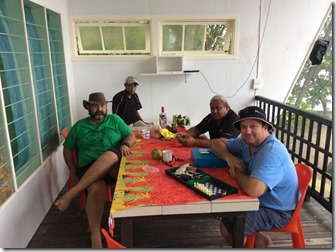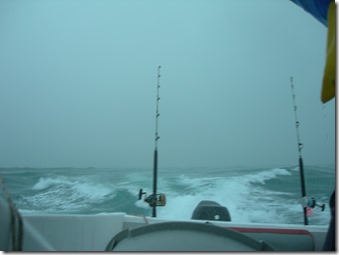After a very successful two weeks in NZ I headed to Papua New Guinea to visit an ex work colleague Tewie van den Berg. Tewie used to be my line manager when I started working as trainee Area Manager in Grampian’s Southern region. I owe a lot to Tewie who mentored me at the beginning of my career. He helped me to develop my management skills and improve my knowledge of the industry. We have remained in contact and when I was awarded my Nuffield Scholarship I decided it was an ideal opportunity to visit him in Papua New Guinea where he now works in the poultry industry there as part of my research. Tewie currently manages the broiler operation for Tablebirds in the Lae area of PNG. Tablebirds is part Mainland Holdings. The company processes 220,000 birds per week in their Lae processing plant.
The broilers are reared in a combination of company and contract grower farms. Stocking densities are kept low to reduce the risk of mortality in hot weather. Birds are stocked at 15 birds/m2 on company farms and at 10 birds/m2 on contract grower farms.
Contract growers
The majority of birds produced for the company are reared by contract growers. These farms are generally very small and often consists of only one house. The farms tend to be made up of wooden sheds with palm roofs and ground floors. The sides are generally open to ensure maximum airflow over the birds. The equipment on the contract grower farms are generally manually operated. Feed and water is carried in by the owner who lives near the chicken house. The contract grower farms are situated in the rural areas around Lae.
Company farms
The company farms are in 2 main broiler complexes each containing multiple farms. Security is a big concern in PNG and the complexes are fenced with security guards ensuring the birds are not stolen and staff are protected.
Labour is cheap and mechanisation is expensive in PNG so lots of tasks are completed manually. The average wage of a labourer in PNG is about 3 kina (K) per hour. This is about £0.85 per hour.
Research farm
Tablebirds has a trial farm on the Wanaru complex. The farm is managed by Nellie Tonga. I was impressed by her organisational skills and how professionally she runs the trial farm. This facility is used to trial different feeds and other new ideas. Since conditions in PNG are so different to the conditions in many other broiler producing countries it is important that new ideas are tested thoroughly in local conditions before being implemented.
Broiler farms
PNG is only 6o south of the equator so heat and high humidity are big concerns on the farms and to transport. All the sheds are built with open sides to ensure the maximum airflow to keep the birds cool all year round. Many sheds have also been fitted with fans to increase the airflow over the birds. The quality of the facilities on the company farms are very good with pan feeders and nipple drinkers. This helps to get the best growing performance on expensive feed. Most of the raw materials are imported so the cost of feed is very expensive. For this reason local materials are constantly trialed to reduce the cost of the feed.
We were present at the delivery of day old chicks to one of the farms on the Nadzap broiler complex. It was striking to see the amount of guarding on the chick delivery vehicle. Both the cab and the back of the lorry were covered in thick metal guarding to ensure that no chicks are stolen while the load is in transit from the hatchery. There were a group of about 8 men waiting for the delivery and as soon as the lorry was unlocked the men started carrying stacks of chick boxes down to the brooding area of the shed. The sheds have got earth floors so it is not be possible to wheel trollies down the sheds as is the practise in more developed countries. To ensure the chicks are given the best possible start, an end of a shed is separated and prepared for the newly hatched chicks. Paper with feed is laid wall to wall in the brooding area to ensure the chicks do not access any shavings. Chicks will occasionally eat shavings if feed is not readily available and lots of paper with feed on will reduce the chances of litter eating. Additional water hoppers are put in the brooding area to make sure that chicks have ample water and do not get dehydrated. We visited the same shed a day later and were pleased to see a good level of crop fill in the chicks after the first 24 hours. Counting the number of chicks with full crops is a good measure of assessing how well the chicks are settling in.
Processing plant
Warren Chandler works as the Processing Plant Manager and he took me on a tour through the plant.
The site processes about 220 000 birds per week. All the broilers are caught by hand. The crates with live birds are loaded by hand before being transported to the processing plant. The crates are locked in the back of the lorry to ensure people can not jump on and steal chicken off the side of the lorry. Live bird lorries travel in convoy for greater safety as it is not uncommon for lorries to be stopped and the birds to be stolen. 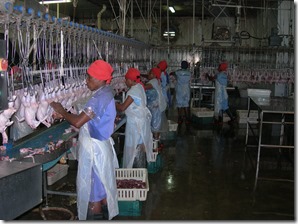
Slaughter plants are not regulated by government legislation and it is up to the plant to monitor and maintain HACCP procedures. The plant uses electric stunning.
The EV equipment in the plant is due to be replaced in the near future as it is nearing the end of its serviceable life. There are a lot of staff on the EV line that will remove anything that was not removed by the EV machines.
The company uses an immersion chiller to cool the carcasses. Chlorine is used as an anti microbial treatment. There is a 32 minute dwell time for the carcasses in the immersion chiller.
The meat is packed in a plastic tray covered in cling film. Leak-proof packaging will add to the cost of the product so it is not a priority at this point in time. The meat is frozen on site for 4 hours before the product is put into freezer containers to be transported. About 60 % of the product is shipped to the capital Port Moresby. The rest is sold locally. The temperature in the containers is below -18 oC.
Because labour is cheap there are lots of staff in the factory. If the company mechanise the processing plant too much they will put locals out of work and this could lead to unrest in the local community.
The processing plant employs 270 people per shift. There are 2 shifts working Monday to Friday. In total the site employs 700 people. This includes maintenance, office, production and catching and collection.
Market
80% of the birds produced are cut into portions. This utilises the whole carcass so the product is cheaper to buy. The average wage is very low and the public is not very affluent and can not afford to pay high prices for the meat. A whole bird costs about K22 whereas the 900 g multipack pack will sell for about K15.
The whole birds will sell in double packs so it can feed big families. There is often an additional family members staying in the main house. The double whole bird pack sells for K40.
Dr Keith Galgal
I met with Dr Keith Galgal during my time in PNG. He works as the Corporate Affairs and Research Manager for Mainland Holdings in Lae. He is also the secretary of the Poultry Industry Association of PNG.
Dr Galgal gave me an overview of the poultry industry in PNG. He also gave me his thoughts on the situation with Campylobacter in PNG. Currently campylobacter is not a government priority so no testing is done in PNG. There are no approved laboratories in PNG that can test for campylobacter.
The industry is aware of its responsibility to provide a saver product and is very keen to explore means of achieving this. Biosecurity has been improved over recent years and this has helped improve performance and also reduce the level of pathogens like Salmonella. Although no testing is currently done for campylobacter the industry is confident that better biosecurity will reduce the level of Campylobacter. 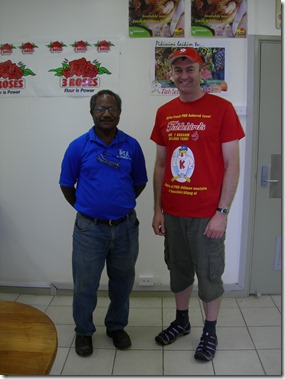
Healthcare is very limited especially in rural areas of PNG. People are unlikely to go to the doctor with campylobacter symptoms so most cases go unreported. HIV is becoming an increasingly big issue in the country. People with weakened immune systems will have a greater risk of developing complications from campylobacter.
Education of how to handle chicken is very limited. Most of the poultry produced by Tablebirds are frozen and sent to the capital Port Moresby to be sold to local buyers and markets. People often buy frozen chicken then thaw the meat to sell it on local markets as fresh. Although the campylobacter will be killed by the freezing process the way the thawed meat is sold could potentially have other food safety issues.
Crocodile farm
I visited the Mainland Holdings crocodile farm in Lae. All the crocodiles are Salt Water Crocodiles and are reared for their high quality leather. The salt water crocodile leather is very sought after and the biggest markets for the leather products are Japan and France.
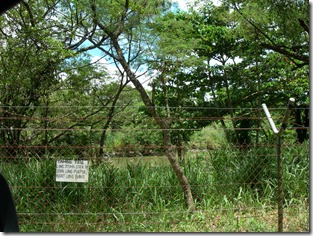 The breeding crocodiles are kept in big enclosures with lots of water and vegetation. People will check the vegetation daily to identify new nests. Once found nests will be marked until the eggs are laid. Females will lay between 50 and 60 eggs. When the eggs are collected it is important that they are not turned. They must be placed in the hatching baskets in the exact position they were found in the nest. If the eggs are turned the hatchlings will be deformed.
The breeding crocodiles are kept in big enclosures with lots of water and vegetation. People will check the vegetation daily to identify new nests. Once found nests will be marked until the eggs are laid. Females will lay between 50 and 60 eggs. When the eggs are collected it is important that they are not turned. They must be placed in the hatching baskets in the exact position they were found in the nest. If the eggs are turned the hatchlings will be deformed.
I found the hatching process particularly interesting. As with other reptiles, the sex of the hatchling will depend on the temperature the eggs were exposed to during incubation. Eggs are kept at between 32 and 34 oC so more males will hatch. Males grow faster than females and are the preferred sex to rear. Humidity in the incubators has to be 99.9% to get the best environment for the eggs. The incubation period is 3 months. The newly hatched crocodiles are kept in water in the nursery for one week before going to the nursery pen.
As the crocodiles get bigger they will be moved to bigger pens until they are at correct weight to be processed. There is a processing facility on site.
I really enjoyed my visit to PNG and was fascinated by how well broilers can be reared in such challenging environmental conditions. It is a beautiful country with so much potential.
I would like to thank the following people for making my stay in PNG possible.
- Tewie van den Berg for arranging my farm visits, offering me a bed and feeding me for the week. The trip to Salamaua Island is one that I will never forget.
- Sebastian Tawa and Philip Inguba for taking me round so many of the contract grower farms, explaining so many of the local traditions and trying to teach me Pigeon English.
- Warren Chandler for taking me round the processing plant and showing me that I am not as good at chess as I thought.
- Michael Lifu for getting us back safely from Salamaua Island in the middle of a tropical storm.
- Dr Keith Galgal for spending time with me to explain the industry and the state of campylobacter in PNG.

